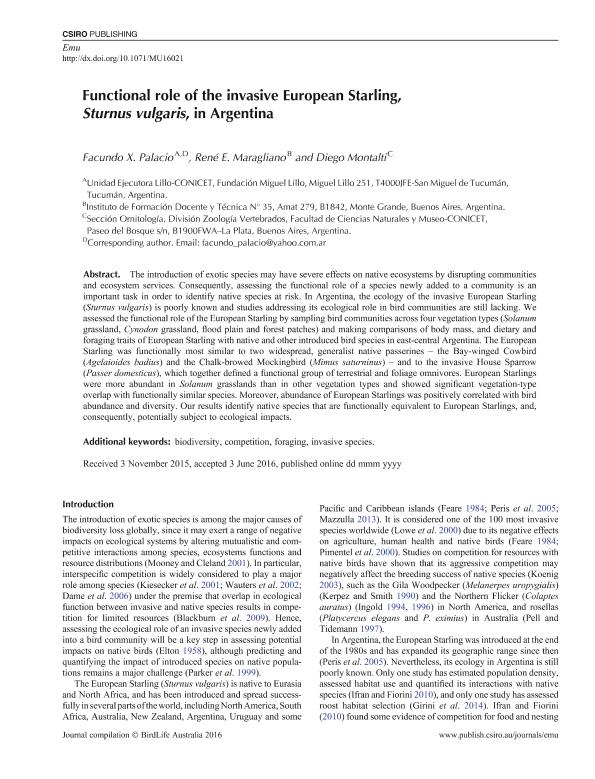Mostrar el registro sencillo del ítem
dc.contributor.author
Palacio, Facundo Xavier

dc.contributor.author
Maragliano, René E.
dc.contributor.author
Montalti, Diego

dc.date.available
2018-08-22T18:30:26Z
dc.date.issued
2016-06
dc.identifier.citation
Palacio, Facundo Xavier; Maragliano, René E.; Montalti, Diego; Functional role of the invasive European Starling, Sturnus vulgaris, in Argentina; Csiro Publishing; Emu; 116; 4; 6-2016; 387-393
dc.identifier.issn
0158-4197
dc.identifier.uri
http://hdl.handle.net/11336/56628
dc.description.abstract
The introduction of exotic species may have severe effects on native ecosystems by disrupting communities and ecosystem services. Consequently, assessing the functional role of a species newly added to a community is an important task in order to identify native species at risk. In Argentina, the ecology of the invasive European Starling (Sturnus vulgaris) is poorly known and studies addressing its ecological role in bird communities are still lacking. We assessed the functional role of the European Starling by sampling bird communities across four vegetation types (Solanum grassland, Cynodon grassland, flood plain and forest patches) and making comparisons of body mass, and dietary and foraging traits of European Starling with native and other introduced bird species in east-central Argentina. The European Starling was functionally most similar to two widespread, generalist native passerines -The Bay-winged Cowbird (Agelaioides badius) and the Chalk-browed Mockingbird (Mimus saturninus) -And to the invasive House Sparrow (Passer domesticus), which together defined a functional group of terrestrial and foliage omnivores. European Starlings were more abundant in Solanum grasslands than in other vegetation types and showed significant vegetation-Type overlap with functionally similar species. Moreover, abundance of European Starlings was positively correlated with bird abundance and diversity. Our results identify native species that are functionally equivalent to European Starlings, and, consequently, potentially subject to ecological impacts.
dc.format
application/pdf
dc.language.iso
eng
dc.publisher
Csiro Publishing

dc.rights
info:eu-repo/semantics/openAccess
dc.rights.uri
https://creativecommons.org/licenses/by-nc-sa/2.5/ar/
dc.subject
Biodiversity
dc.subject
Competition
dc.subject
Foraging
dc.subject
Invasive Species
dc.subject.classification
Otras Ciencias Biológicas

dc.subject.classification
Ciencias Biológicas

dc.subject.classification
CIENCIAS NATURALES Y EXACTAS

dc.title
Functional role of the invasive European Starling, Sturnus vulgaris, in Argentina
dc.type
info:eu-repo/semantics/article
dc.type
info:ar-repo/semantics/artículo
dc.type
info:eu-repo/semantics/publishedVersion
dc.date.updated
2018-08-17T16:55:07Z
dc.journal.volume
116
dc.journal.number
4
dc.journal.pagination
387-393
dc.journal.pais
Australia

dc.journal.ciudad
Collingwood
dc.description.fil
Fil: Palacio, Facundo Xavier. Consejo Nacional de Investigaciones Científicas y Técnicas. Centro Científico Tecnológico - Tucumán. Unidad Ejecutora Lillo; Argentina
dc.description.fil
Fil: Maragliano, René E.. Instituto de Formación Docente y Técnica Nro 35; Argentina
dc.description.fil
Fil: Montalti, Diego. Consejo Nacional de Investigaciones Científicas y Técnicas; Argentina. Universidad Nacional de La Plata. Facultad de Ciencias Naturales y Museo. División Zoología de Vertebrados. Sección Ornitología; Argentina
dc.journal.title
Emu

dc.relation.alternativeid
info:eu-repo/semantics/altIdentifier/doi/https://dx.doi.org/10.1071/MU16021
dc.relation.alternativeid
info:eu-repo/semantics/altIdentifier/url/https://www.tandfonline.com/doi/abs/10.1071/MU16021
Archivos asociados
